Characteristics of Basalt Macro-Fiber Reinforced Recycled Aggregate Concrete
Abstract
:1. Introduction
2. Research Significance
3. Experimental Program
3.1. Materials
3.2. Mixture Procedure and Testing Methods
4. Results
4.1. Workability
4.2. Mechanical Characteristics
4.2.1. Compressive Strength and Modulus
4.2.2. Splitting Tensile Strength
4.2.3. Flexural Performance
4.3. Durability Properties
4.3.1. Water Absorption and Sorptivity
4.3.2. Abrasion Resistance
4.3.3. Ultrasonic Pulse Velocity
5. Discussion
6. Idealized Tensile Softening Laws
6.1. Finite Element Modeling
6.2. Tensile Softening Law
6.3. Validation of the Tensile Softening Law
7. Conclusions
- The use of BMF was detrimental to the concrete workability. At νf of 1.5%, the NSC and HSC with 30% RCA showed similar slump reductions of 32 and 26%, respectively. Respective slump reductions of 51 and 84% were recorded at 60% RCA.
- The plain concrete mixtures with 30 and 60% showed approximately 19 and 32% reductions in the cube compressive strength, respectively, relative to that of their NA-based counterparts. The respective cylinder strength reductions were 31 and 51%, signifying an increased sensitivity of the plain RCA-based mixtures to the slenderness effect. The addition of BMF at νf of 0.5% increased the compressive strength of the NSC and HSC with 30% RCA by 8%, on average. At 60% RCA, the compressive strength gain was 26–34% for the NSC and 9–13% for the HSC. The use of a higher BMF content resulted in minimal additional strength gain or a reduced strength gain. The compressive strength of all RCA-based mixtures reinforced with BMF was, however, lower than that of the NA-based plain mixture.
- The splitting tensile strengths of the plain NSC mixtures with 30 and 60% RCA were 6 and 13% lower than those of their NA-based counterparts, respectively. The plain HSC with RCA exhibited higher respective strength reductions of 29 and 28%. The BMF-reinforced NSC and HSC with 30% RCA showed splitting tensile strength gains of 12–46% and 7–53%, respectively. At 60% RCA, the use of BMF with νf ≤ 1.0% improved the splitting tensile strengths of the NSC and HSC by up to 16 and 22%, respectively. Minimal or no further enhancement in the splitting tensile strength was record at νf of 1.5%. The addition of BMF to RCA mixtures at νf of 1.0% restored the original splitting tensile strength of the NA-based plain mixture, except for the HSC with 60% RCA, where the strength was not fully restored.
- At 30% RCA, the plain NSC mixture exhibited no flexural strength reduction, whereas its HSC counterpart exhibited a flexural strength reduction of 19%. At 60% RCA, the plain NSC and HSC showed flexural strength reductions of 22 and 26%, respectively, relative to those of their NA-based counterparts. The addition of BMF at νf ≤ 1.0% improved the flexural strength of the NSC and HSC with 30% RCA by up to 18 and 59%, respectively. At νf of 1.5%, minimal additional strength gain or a declining trend of the strength occurred. The addition of BMF at νf of 1.0% to NSC and HSC with 30% RCA fully restored the original flexural strength of the NA-based mixtures. At 60% RCA, it was necessary to use νf of 1.5% to restore the original flexural strength of the NA-based concrete.
- Partial replacement of NA by RCA increased the water absorption, reduced the UPV, and decreased the abrasion resistance. The addition of BMF to the RCA-based concrete tended to reduce the water absorption, improve the abrasion resistance, and slightly increased the UPV, irrespective of the initial concrete grade.
- New idealized tensile softening laws were established for RCA-based concrete mixtures reinforced with BMF. A comparison between the numerical and experimental flexural responses verified the validity of the tensile softening laws.
- Future research should investigate the effectiveness of using hybrid basalt fibers with different lengths rather than single-length fibers in improving the properties of NA- and RCA-based concrete. The shear behavior of large-scale concrete beams made with RCA and BMF should be examined in future work.
Author Contributions
Funding
Institutional Review Board Statement
Informed Consent Statement
Data Availability Statement
Conflicts of Interest
References
- Radonjanin, V.; Malešev, M.; Marinković, S.; Al Malty, A.E.S. Green Recycled Aggregate Concrete. Constr. Build. Mater. 2013, 47, 1503–1511. [Google Scholar] [CrossRef]
- Bandow, N.; Gartiser, S.; Ilvonen, O.; Schoknecht, U. Evaluation of the Impact of Construction Products on the Environment by Leaching of Possibly Hazardous Substances. Environ. Sci. Eur. 2018, 30, 14. [Google Scholar] [CrossRef] [PubMed] [Green Version]
- Bakaeva, N.V.; Klimenko, M.Y. Technique for Reduction of Environmental Pollution from Construction Wastes. IOP Conf. Ser. Mater. Sci. Eng. 2017, 262, 012195. [Google Scholar] [CrossRef]
- Alzard, M.H.; El-Hassan, H.; El-Maaddawy, T. Environmental and Economic Life Cycle Assessment of Recycled Aggregates Concrete in the United Arab Emirates. Sustainability 2021, 13, 10348. [Google Scholar] [CrossRef]
- Prakash, R.; Thenmozhi, R.; Raman, S.N.; Subramanian, C. Characterization of Eco-Friendly Steel Fiber-Reinforced Concrete Containing Waste Coconut Shell as Coarse Aggregates and Fly Ash as Partial Cement Replacement. Struct. Concr. 2020, 21, 437–447. [Google Scholar] [CrossRef]
- Prakash, R.; Raman, S.N.; Subramanian, C.; Divyah, N. 6—Eco-Friendly Fiber-Reinforced Concretes. In Handbook of Sustainable Concrete and Industrial Waste Management; Colangelo, F., Cioffi, R., Farina, I., Eds.; Woodhead Publishing Series in Civil and Structural Engineering; Woodhead Publishing: Sawston, UK, 2022; pp. 109–145. ISBN 978-0-12-821730-6. [Google Scholar]
- Debieb, F.; Courard, L.; Kenai, S.; Degeimbre, R. Roller Compacted Concrete with Contaminated Recycled Aggregates. Constr. Build. Mater. 2009, 23, 3382–3387. [Google Scholar] [CrossRef]
- Guo, H.; Shi, C.; Guan, X.; Zhu, J.; Ding, Y.; Ling, T.-C.; Zhang, H.; Wang, Y. Durability of Recycled Aggregate Concrete—A Review. Cem. Concr. Compos. 2018, 89, 251–259. [Google Scholar] [CrossRef]
- Kachouh, N.; El-Hassan, H.; El-Maaddawy, T. Effect of Steel Fibers on the Performance of Concrete Made with Recycled Concrete Aggregates and Dune Sand. Constr. Build. Mater. 2019, 213, 348–359. [Google Scholar] [CrossRef]
- Kachouh, N.; El-Hassan, H.; El-Maaddawy, T. Influence of Steel Fibers on the Flexural Performance of Concrete Incorporating Recycled Concrete Aggregates and Dune Sand. J. Sustain. Cem.-Based Mater. 2021, 10, 165–192. [Google Scholar] [CrossRef]
- Balouch, S.U.; Forth, J.P.; Granju, J.-L. Surface Corrosion of Steel Fibre Reinforced Concrete. Cem. Concr. Res. 2010, 40, 410–414. [Google Scholar] [CrossRef]
- Fang, S.-E.; Hong, H.-S.; Zhang, P.-H. Mechanical Property Tests and Strength Formulas of Basalt Fiber Reinforced Recycled Aggregate Concrete. Materials 2018, 11, 1851. [Google Scholar] [CrossRef] [PubMed] [Green Version]
- Wang, Y.; Hughes, P.; Niu, H.; Fan, Y. A New Method to Improve the Properties of Recycled Aggregate Concrete: Composite Addition of Basalt Fiber and Nano-Silica. J. Clean. Prod. 2019, 236, 117602. [Google Scholar] [CrossRef]
- Katkhuda, H.; Shatarat, N. Shear Behavior of Reinforced Concrete Beams Using Treated Recycled Concrete Aggregate. Constr. Build. Mater. 2016, 125, 63–71. [Google Scholar] [CrossRef]
- Ali, B.; Qureshi, L.A.; Raza, A.; Nawaz, M.A.; Rehman, S.U.; Rashid, M.U. Influence of Glass Fibers on Mechanical Properties of Concrete with Recycled Coarse Aggregates. Civ. Eng. J. 2019, 5, 1007–1019. [Google Scholar] [CrossRef] [Green Version]
- Lee, S. Effect of Nylon Fiber Addition on the Performance of Recycled Aggregate Concrete. Appl. Sci. 2019, 9, 767. [Google Scholar] [CrossRef] [Green Version]
- Ahmed, T.W.; Ali, A.A.M.; Zidan, R.S. Properties of High Strength Polypropylene Fiber Concrete Containing Recycled Aggregate. Constr. Build. Mater. 2020, 241, 118010. [Google Scholar] [CrossRef]
- Meesala, C.R. Influence of Different Types of Fiber on the Properties of Recycled Aggregate Concrete. Struct. Concr. 2019, 20, 1656–1669. [Google Scholar] [CrossRef]
- Dong, J.F.; Wang, Q.Y.; Guan, Z.W. Material Properties of Basalt Fibre Reinforced Concrete Made with Recycled Earthquake Waste. Constr. Build. Mater. 2017, 130, 241–251. [Google Scholar] [CrossRef]
- Das, C.S.; Dey, T.; Dandapat, R.; Mukharjee, B.B.; Kumar, J. Performance Evaluation of Polypropylene Fibre Reinforced Recycled Aggregate Concrete. Constr. Build. Mater. 2018, 189, 649–659. [Google Scholar] [CrossRef]
- Divyah, N.; Thenmozhi, R.; Neelamegam, M.; Prakash, R. Characterization and Behavior of Basalt Fiber-Reinforced Lightweight Concrete. Struct. Concr. 2021, 22, 422–430. [Google Scholar] [CrossRef]
- Srividhya, S.; Vidjeapriya, R.; Neelamegam, M. Enhancing the Performance of Hyposludge Concrete Beams Using Basalt Fiber and Latex under Cyclic Loading. Comput. Concr. 2021, 28, 93–105. [Google Scholar]
- Prakash, R.; Thenmozhi, R.; Raman, S.N.; Subramanian, C. Fibre Reinforced Concrete Containing Waste Coconut Shell Aggregate, Fly Ash and Polypropylene Fibre. Rev. Fac. Ing. Univ. Antioquia 2020, 94, 33–42. [Google Scholar] [CrossRef] [Green Version]
- Ahmed, M.; Islam, S.; Nazar, S.; Khan, R.A. A Comparative Study of Popular Concrete Mix Design Methods from Qualitative and Cost-Effective Point of View for Extreme Environment. Arab. J. Sci. Eng. 2016, 41, 1403–1412. [Google Scholar] [CrossRef]
- Gebretsadik, B.; Jdidirendi, K.; Farhangi, V.; Karakouzian, M. Application of Ultrasonic Measurements for the Evaluation of Steel Fiber Reinforced Concrete. Eng. Technol. Appl. Sci. Res. 2021, 11, 6662–6667. [Google Scholar] [CrossRef]
- Moradi, N.; Tavana, M.H.; Habibi, M.R.; Amiri, M.; Moradi, M.J.; Farhangi, V. Predicting the Compressive Strength of Concrete Containing Binary Supplementary Cementitious Material Using Machine Learning Approach. Materials 2022, 15, 5336. [Google Scholar] [CrossRef] [PubMed]
- Sorelli, L.G.; Meda, A.; Plizzari, G.A. Bending and Uniaxial Tensile Tests on Concrete Reinforced with Hybrid Steel Fibers. J. Mater. Civ. Eng. 2005, 17, 519–527. [Google Scholar] [CrossRef]
- Yoo, D.-Y.; Kang, S.-T.; Yoon, Y.-S. Effect of Fiber Length and Placement Method on Flexural Behavior, Tension-Softening Curve, and Fiber Distribution Characteristics of UHPFRC. Constr. Build. Mater. 2014, 64, 67–81. [Google Scholar] [CrossRef]
- Amin, A.; Foster, S.J.; Muttoni, A. Evaluation of the Tensile Strength of SFRC as Derived from Inverse Analysis of Notched Bending Tests. In Proceedings of the VIII International Conference on Fracture Mechanics of Concrete and Concrete Structures, FraMCoS-8, Toledo, Spain, 10–14 March 2013. [Google Scholar]
- Ernst & Sohn. Fédération Internationale du Béton. In Fib Model Code for Concrete Structures; Ernst & Sohn: Lausanne, Switzerland, 2010. [Google Scholar]
- Kachouh, N.; El-Maaddawy, T.; El-Hassan, H.; El-Ariss, B. Numerical Modeling of Concrete Deep Beams Made with Recycled Aggregates and Steel Fibers. Buildings 2022, 12, 529. [Google Scholar] [CrossRef]
- Shoaib, S.; El-Maaddawy, T.; El-Hassan, H.; El-Ariss, B.; Alsalami, M. Fresh and Hardened Properties of Concrete Reinforced with Basalt Macro-Fibers. Buildings 2022, 12, 1136. [Google Scholar] [CrossRef]
- ACI Committee 211.1; Standard Practice for Selecting Proportions for Normal, Heavyweight, and Mass Concrete. American Concrete Institute: Farmington Hills, MI, USA, 2009.
- ASTM C150/C150M—19a; Standard Specification for Portland Cement. ASTM International: West Conshohocken, PA, USA, 2012.
- ReforceTech AS, Røyken, Norway. Available online: https://reforcetech.com/ (accessed on 7 August 2022).
- Sim, J.; Park, C.; Moon, D.Y. Characteristics of Basalt Fiber as a Strengthening Material for Concrete Structures. Compos. Part B Eng. 2005, 36, 504–512. [Google Scholar] [CrossRef]
- Li, Z.; Ma, J.; Ma, H.; Xu, X. Properties and Applications of Basalt Fiber and Its Composites. IOP Conf. Ser. Earth Environ. Sci. 2018, 186, 012052. [Google Scholar] [CrossRef]
- Dhand, V.; Mittal, G.; Rhee, K.Y.; Park, S.-J.; Hui, D. A Short Review on Basalt Fiber Reinforced Polymer Composites. Compos. Part B Eng. 2015, 73, 166–180. [Google Scholar] [CrossRef]
- Larrinaga, P.; Chastre, C.; Biscaia, H.C.; San-José, J.T. Experimental and Numerical Modeling of Basalt Textile Reinforced Mortar Behavior under Uniaxial Tensile Stress. Mater. Des. 2014, 55, 66–74. [Google Scholar] [CrossRef]
- ASTM C127-15; Standard Test Method for Relative Density (Specific Gravity) and Absorption of Coarse Aggregate. ASTM International: West Conshohocken, PA, USA, 2015.
- ASTM C136/C136M-19; Test Method for Sieve Analysis of Fine and Coarse Aggregates. ASTM International: West Conshohocken, PA, USA, 2020.
- ASTM C88/C88M-18; Standard Test Method for Soundness of Aggregates by Use of Sodium Sulfate or Magnesium Sulfate. ASTM International: West Conshohocken, PA, USA, 2018.
- ASTM C131-06; Standard Test Method for Resistance to Degradation of Small-Size Coarse Aggregate by Abrasion and Im pact in the Los Angeles Machine. ASTM International: West Conshohocken, PA, USA, 2006.
- ASTM C29/C29M-17a; Test Method for Bulk Density (Unit Weight) and Voids in Aggregate. ASTM International: West Conshohocken, PA, USA, 2017.
- ASTM C31/C31M; Standard Test Practice for Making and Curing Concrete Test Specimens in the Field—ELearning Course. ASTM International: West Conshohocken, PA, USA, 2010.
- ASTM C 143; Test Method for Slump of Hydraulic-Cement Concrete. ASTM International: West Conshohocken, PA, USA, 2012.
- BS EN 12350-3:2019; Testing Fresh Concrete. Vebe Test. British Standards: London, UK, 2019.
- BS EN 12390-3:2019; Testing Hardened Concrete. Compressive Strength of Test Specimens. British Standards: London, UK, 2019.
- ASTM C39; Test Method for Compressive Strength of Cylindrical Concrete Specimens. ASTM International: West Conshohocken, PA, USA, 2018.
- ASTM C469-02; Test Method for Static Modulus of Elasticity and Poissons Ratio of Concrete in Compression. ASTM International: West Conshohocken, PA, USA, 2014.
- ASTM C496/C496M-17; Test Method for Splitting Tensile Strength of Cylindrical Concrete Specimens. ASTM International: West Conshohocken, PA, USA, 2017.
- ASTM C1609/C1609M-19a; Test Method for Flexural Performance of Fiber-Reinforced Concrete (Using Beam With Third-Point Loading). ASTM International: West Conshohocken, PA, USA, 2010.
- ASTM C642-21; Standard Test Method for Density, Absorption, and Voids in Hardened Concrete. ASTM International: West Conshohocken, PA, USA, 2006.
- ASTM C1585-20; Standard Test Method for Measurement of Rate of Absorption of Water by Hydraulic-Cement Concretes. ASTM International: West Conshohocken, PA, USA, 2013.
- ASTM C1747/C1747M-13; Test Method for Determining Potential Resistance to Degradation of Pervious Concrete by Impact and Abrasion. ASTM International: West Conshohocken, PA, USA, 2013.
- ASTM C597; Standard Test Method for Pulse Velocity Through Concrete. ASTM International: West Conshohocken, PA, USA, 2016.
- Ratay, R.T. Structural Condition Assessment; Wiley: New Jersey, NB, Canada, 2005. [Google Scholar]
- ATENA Computer Software, Cervenka Consulting s.r.o.: Prague, Czech Republic. Available online: https://www.cervenka.cz/products/atena/ (accessed on 21 June 2022).
- Ashour, S.A.; Hasanain, G.S.; Wafa, F.F. Shear Behavior of High-Strength Fiber Reinforced Concrete Beams. Struct. J. 1992, 89, 176–184. [Google Scholar] [CrossRef]
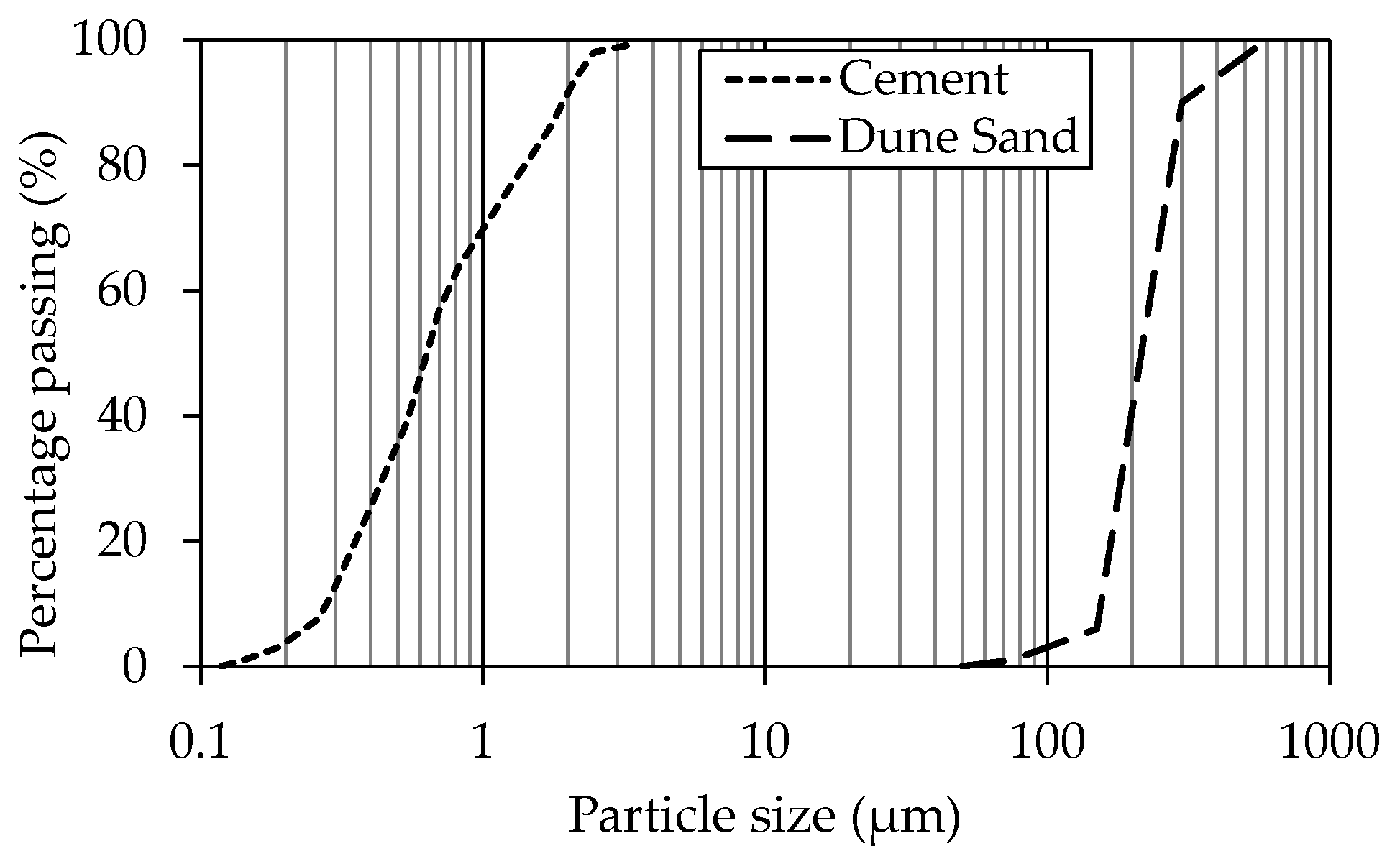







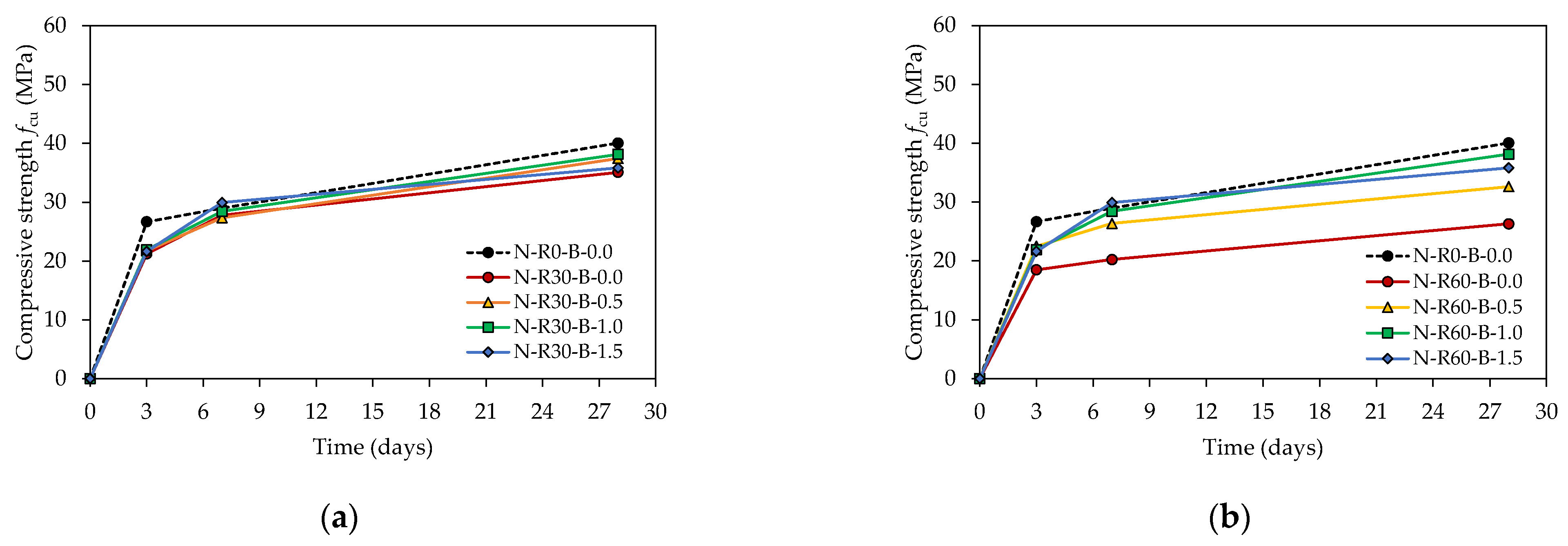
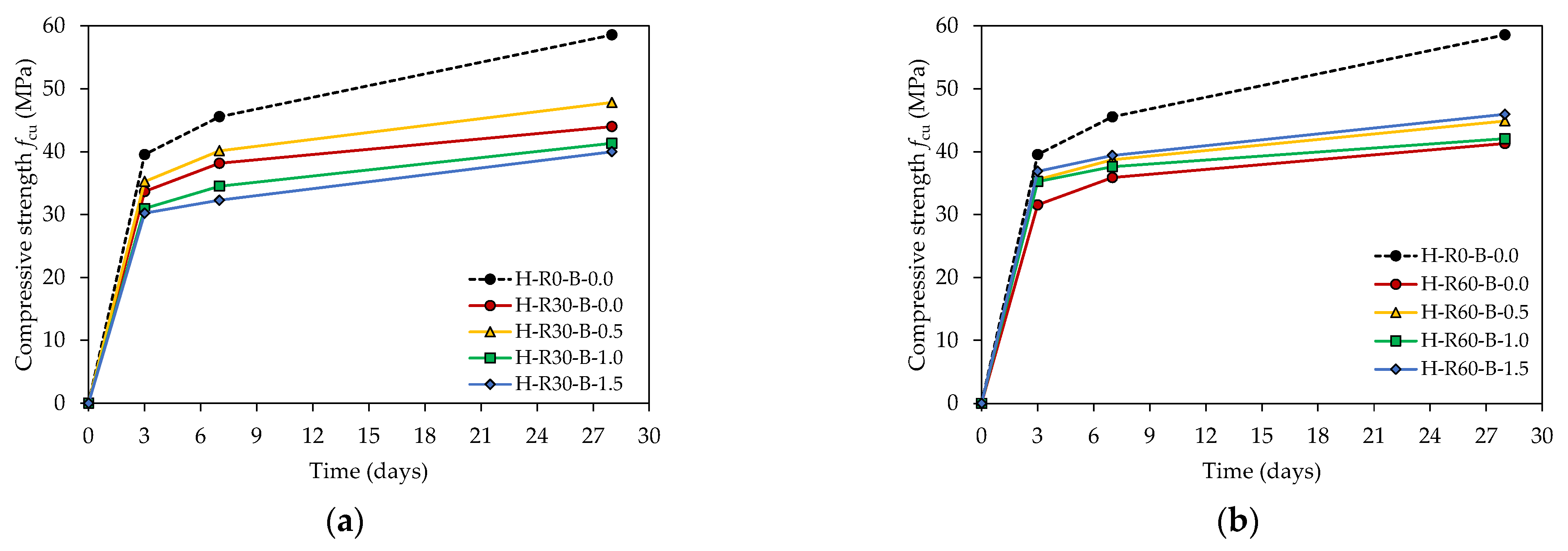
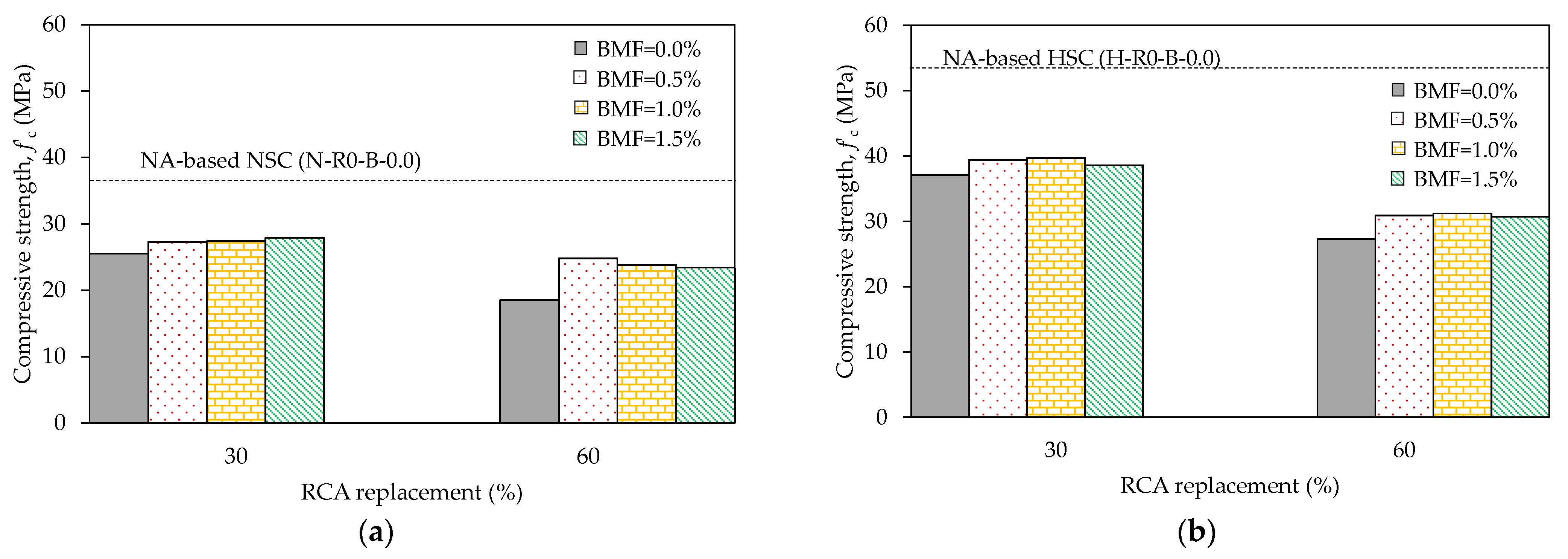

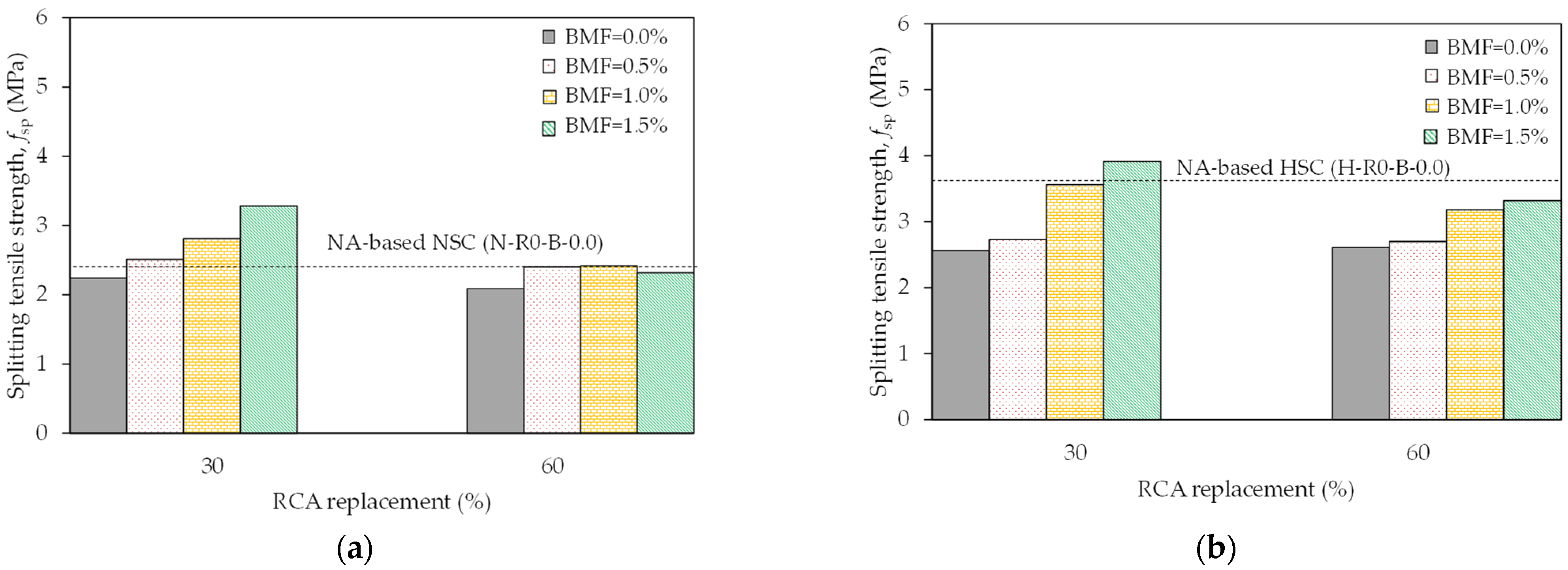
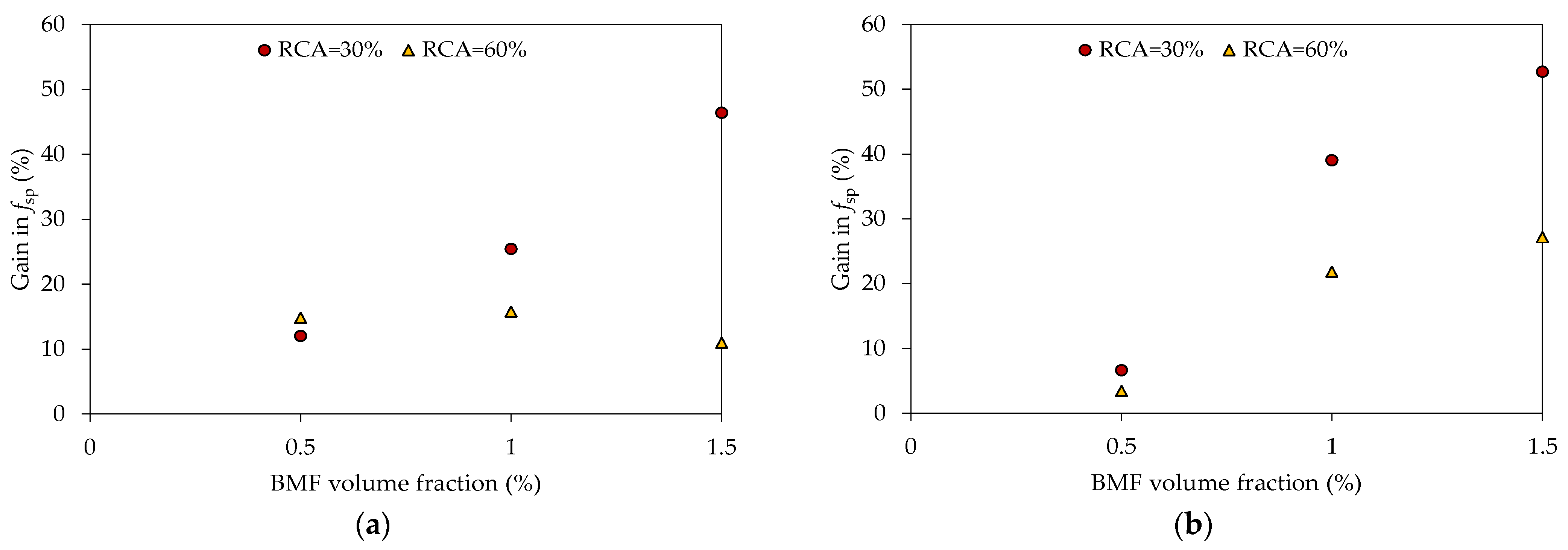





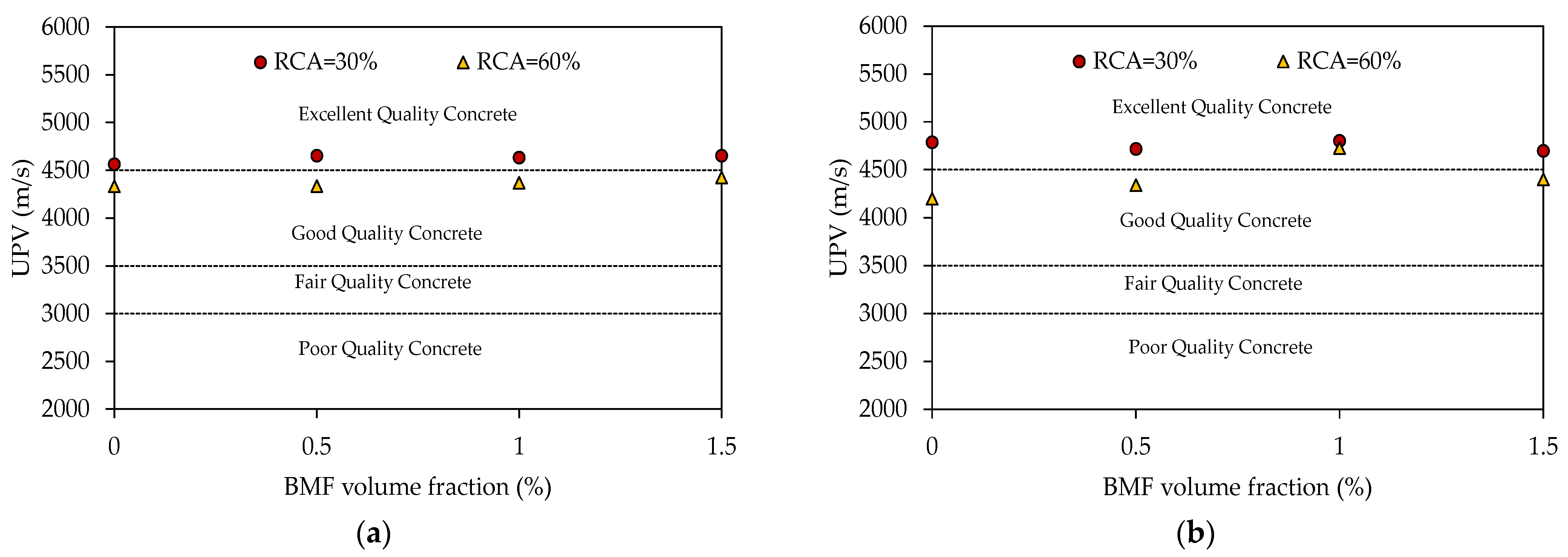

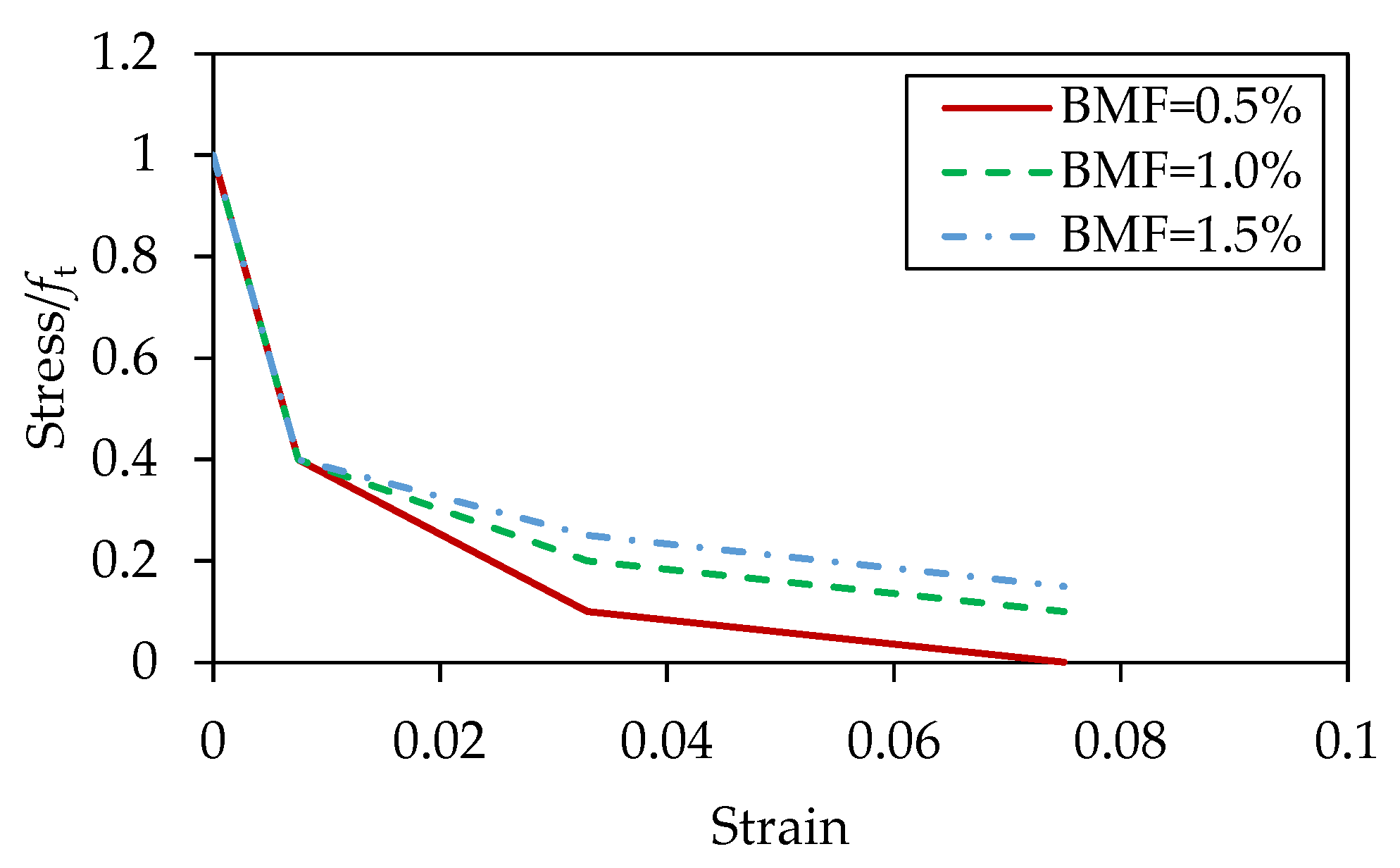




| Group | Mixture ID | Mass (kg/m3) | νf (%) | ||||||
|---|---|---|---|---|---|---|---|---|---|
| Cement | Sand | NA | RCA | Water | SP | BMF | |||
| NSC | N-R0-B-0.0 | 470 | 659 | 1080 | 0 | 230 | 0.47 | 0.0 | 0.0 |
| N-R30-B-0.0 | 470 | 659 | 756 | 324 | 230 | 0.47 | 0.0 | 0.0 | |
| N-R60-B-0.0 | 470 | 659 | 432 | 648 | 230 | 0.47 | 0.0 | 0.0 | |
| N-R30-B-0.5 | 470 | 659 | 756 | 324 | 230 | 0.47 | 10.5 | 0.5 | |
| N-R30-B-1.0 | 470 | 659 | 756 | 324 | 230 | 0.47 | 21.0 | 1.0 | |
| N-R30-B-1.5 | 470 | 659 | 756 | 324 | 230 | 0.47 | 31.5 | 1.5 | |
| N-R60-B-0.5 | 470 | 659 | 432 | 648 | 230 | 0.47 | 10.5 | 0.5 | |
| N-R60-B-1.0 | 470 | 659 | 432 | 648 | 230 | 0.47 | 21.0 | 1.0 | |
| N-R60-B-1.5 | 470 | 659 | 432 | 648 | 230 | 0.47 | 31.5 | 1.5 | |
| HSC | H-R0-B-0.0 | 617 | 513 | 1080 | 0 | 216 | 0.92 | 0.0 | 0.0 |
| H-R30-B-0.0 | 617 | 513 | 756 | 324 | 216 | 0.92 | 0.0 | 0.0 | |
| H-R60-B-0.0 | 617 | 513 | 432 | 648 | 216 | 0.92 | 0.0 | 0.0 | |
| H-R30-B-0.5 | 617 | 513 | 756 | 324 | 216 | 0.92 | 10.5 | 0.5 | |
| H-R30-B-1.0 | 617 | 513 | 756 | 324 | 216 | 0.92 | 21.0 | 1.0 | |
| H-R30-B-1.5 | 617 | 513 | 756 | 324 | 216 | 0.92 | 31.5 | 1.5 | |
| H-R60-B-0.5 | 617 | 513 | 432 | 648 | 216 | 0.92 | 10.5 | 0.5 | |
| H-R60-B-1.0 | 617 | 513 | 432 | 648 | 216 | 0.92 | 21.0 | 1.0 | |
| H-R60-B-1.5 | 617 | 513 | 432 | 648 | 216 | 0.92 | 31.5 | 1.5 | |
| Property | Unit | ASTM Standard | NA | RCA | DS |
|---|---|---|---|---|---|
| Absorption | % | C127 [40] | 0.40 | 6.58 | - |
| Specific gravity | - | C127 [40] | 2.82 | 2.63 | 2.77 |
| Fineness modulus | - | C136 [41] | 6.82 | 7.44 | 1.45 |
| Surface area | cm2/g | C136 [41] | 2.49 | 2.50 | 116.8 |
| Soundness (MgSO4) | % | C88 [42] | 1.2 | 2.78 | - |
| Los Angeles abrasion | % | C131 [43] | 16.0 | 32.6 | - |
| Dry-rodded density | kg/m3 | C29 [44] | 1635.0 | 1563.0 | 1663.0 |
| Category | Characteristic | Test Standard | Specimen Details | Apparatus |
|---|---|---|---|---|
| Workability | Slump | ASTM C143 [46] | Fresh state | Standard cone |
| Vebe time | BS EN 12350-3:2019 [47] | Fresh state | Triton Engineering England | |
| Mechanical | Cube compressive strength | BS EN 12390-3:2019 [48] | Cube (150 × 150 mm) | Wykeham Farrance Engineering Limited Slough England (2000 kN) |
| Cylinder compressive strength | ASTM C39 [49] | Cylinder (150 Φ × 300 mm) | Wykeham Farrance Engineering Limited Slough England (2000 kN) | |
| Elastic modulus | ASTM C469 [50] | Cylinder (100 Φ × 200 mm) | Wykeham Farrance Engineering Limited Slough England (2000 kN) | |
| Splitting tensile strength | ASTM C496 [51] | Cylinder (150 Φ × 300 mm) | Wykeham Farrance Engineering Limited Slough England (2000 kN) | |
| Flexural strength | ASTM C1609 [52] | Prism (100 mm × 100 mm × 500 mm) | Wykeham Farrance Engineering Limited Slough England (2000 kN) | |
| Durability | Water absorption | ASTM C642 [53] | Disc (100 Φ × 50 mm) | MATEST Italy oven (Temp. range of 0–220 °C) and ACZEL balance (0.01 g resolution) |
| Sorptivity | ASTM C1585 [54] | Disc (100 Φ × 50 mm) | Sorptivity container (25 cm × 25 cm × 5 cm, with fitting ring diameters of 9.5–9.9 cm | |
| Abrasion | ASTM C 1747 [55] | Disc (100 Φ × 50 mm) | Associates Scientific International (ASI) New Delhi India | |
| UPV | ASTM C597 [56] | Cube (150 × 150 mm) | MATEST Italy (40 cm × 30 cm × 18 cm with two 55 kHz probes and connecting cables) |
| Group | Mixture ID | fcu (MPa) 1 | f’c (MPa) 1 | f’c/fcu | Ec (GPa) 1 |
|---|---|---|---|---|---|
| NSC | N-R0-B-0.0 | 40.0 (1.20) | 36.5 (1.73) | 0.91 | 35.6 (3.14) |
| N-R30-B-0.0 | 35.1 (1.69) | 25.5 (1.43) | 0.73 | 30.9 (2.65) | |
| N-R60-B-0.0 | 26.3 (1.45) | 18.5 (0.72) | 0.70 | 26.9 (2.11) | |
| N-R30-B-0.5 | 37.4 (1.10) | 27.3 (1.52) | 0.73 | 24.7 (0.32) | |
| N-R30-B-1.0 | 38.1 (1.32) | 27.4 (0.88) | 0.72 | 26.4 (0.21) | |
| N-R30-B-1.5 | 35.8 (1.73) | 27.9 (0.83) | 0.78 | 27.3 (1.82) | |
| N-R60-B-0.5 | 32.6 (1.45) | 24.8 (2.16) | 0.76 | 24.8 (3.1) | |
| N-R60-B-1.0 | 33.2 (0.78) | 23.8 (1.27) | 0.72 | 23.3 (2.72) | |
| N-R60-B-1.5 | 30.8 (1.04) | 23.4 (1.58) | 0.76 | 21.0 (3.27) | |
| HSC | H-R0-B-0.0 | 58.6 (0.81) | 53.6 (2.15) | 0.91 | 41.9 (3.22) |
| H-R30-B-0.0 | 44.0 (2.50) | 37.1 (2.53) | 0.80 | 30.4 (3.97) | |
| H-R60-B-0.0 | 41.3 (2.53) | 27.3 (1.25) | 0.66 | 29.0 (2.27) | |
| H-R30-B-0.5 | 47.8 (2.23) | 39.4 (1.99) | 0.82 | 27.3 (3.90) | |
| H-R30-B-1.0 | 41.3 (0.59) | 39.7 (1.74) | 0.96 | 26.3 (0.76) | |
| H-R30-B-1.5 | 40.0 (0.79) | 38.6 (2.46) | 0.97 | 26.6 (3.61) | |
| H-R60-B-0.5 | 44.9 (2.47) | 30.9 (1.22) | 0.69 | 27.4 (0.26) | |
| H-R60-B-1.0 | 42.1 (0.46) | 31.2 (1.83) | 0.74 | 24.9 (0.48) | |
| H-R60-B-1.5 | 45.9 (1.66) | 30.7 (4.09) | 0.67 | 26.1 (1.74) |
| Group | Mix ID | Pmax (kN) | fr (MPa) | f600100 (MPa) | f150100 (MPa) | T150100 (J) |
|---|---|---|---|---|---|---|
| NSC | N-R0-B-0.0 | 8.49 (0.18) | 3.82 (0.08) | - | - | - |
| N-R30-B-0.0 | 8.68 (0.09) | 3.90 (0.04) | - | - | - | |
| N-R60-B-0.0 | 6.62 (0.70) | 2.98 (0.32) | - | - | - | |
| N-R30-B-0.5 | 8.99 (0.18) | 4.04 (0.08) | 2.50 (0.32) | 0.34 (0.22) | 9.02 (0.09) | |
| N-R30-B-1.0 | 10.24 (0.98) | 4.61 (0.44) | 2.80 (1.09) | 1.04 (0.30) | 16.87 (1.41) | |
| N-R30-B-1.5 | 10.36 (1.41) | 4.66 (0.64) | 2.43 (0.08) | 0.60 (0.14) | 11.10 (0.79) | |
| N-R60-B-0.5 | 6.93 (0.26) | 3.12 (0.12) | 0.99 (0.21) | 0.32 (0.27) | 5.43 (1.43) | |
| N-R60-B-1.0 | 6.95 (1.24) | 3.13 (0.56) | 1.25 (0.22) | 0.75 (0.13) | 7.21 (1.46) | |
| N-R60-B-1.5 | 9.11 (1.30) | 4.10 (0.59) | 1.92 (0.62) | 0.92 (0.18) | 11.54 (1.49) | |
| HSC | H-R0-B-0.0 | 9.99 (1.32) | 4.50 (0.60) | - | - | - |
| H-R30-B-0.0 | 8.12 (1.24) | 3.65 (0.56) | - | - | - | |
| H-R60-B-0.0 | 7.43 (1.15) | 3.34 (0.52) | - | - | - | |
| H-R30-B-0.5 | 13.05 (2.03) | 5.87 (0.91) | 3.24 (1.98) | 0.20 (0.12) | 12.93 (3.96) | |
| H-R30-B-1.0 | 12.80 (0.79) | 5.76 (0.36) | 2.34 (1.29) | 0.67 (0.04) | 11.05 (0.98) | |
| H-R30-B-1.5 | 10.37 (0.17) | 4.59 (0.14) | 1.82 (0.18) | 0.82(0.03) | 9.68 (0.90) | |
| H-R60-B-0.5 | 8.55 (0.27) | 3.85 (0.12) | 1.76 (0.20) | 0.30 (0.16) | 7.37 (0.34) | |
| H-R60-B-1.0 | 7.53 (1.57) | 3.39 (0.71) | 2.21 (0.29) | 1.03 (0.36) | 11.15 (2.96) | |
| H-R60-B-1.5 | 10.62 (1.59) | 4.78 (0.72) | 2.72 (0.47) | 0.40 (0.02) | 10.49 (1.06) |
| Group | Mixture ID | Water Absorption (%) | Sorptivity × 10−2 (mm/√s) | Abrasion Mass Loss (%) | UPV (m/s) |
|---|---|---|---|---|---|
| NSC | N-R0-B-0.0 | 4.93 | 2.27 | 14.20 | 5149 |
| N-R30-B-0.0 | 5.98 | 3.74 | 21.0 | 4564 | |
| N-R60-B-0.0 | 7.50 | 3.67 | 68.9 | 4331 | |
| N-R30-B-0.5 | 5.63 | 3.80 | 20.7 | 4654 | |
| N-R30-B-1.0 | 5.74 | 3.45 | 19.5 | 4634 | |
| N-R30-B-1.5 | 5.33 | 3.62 | 13.7 | 4654 | |
| N-R60-B-0.5 | 7.44 | 3.37 | 44.51 | 4335 | |
| N-R60-B-1.0 | 6.82 | 3.33 | 41.93 | 4369 | |
| N-R60-B-1.5 | 6.69 | 3.32 | 37.81 | 4425 | |
| HSC | H-R0-B-0.0 | 4.22 | 1.66 | 8.3 | 5079 |
| H-R30-B-0.0 | 4.79 | 2.50 | 19.4 | 4787 | |
| H-R60-B-0.0 | 7.24 | 2.54 | 23.1 | 4198 | |
| H-R30-B-0.5 | 4.65 | 2.32 | 14.2 | 4717 | |
| H-R30-B-1.0 | 4.28 | 2.34 | 14.1 | 4803 | |
| H-R30-B-1.5 | 4.31 | 2.22 | 13.5 | 4697 | |
| H-R60-B-0.5 | 6.27 | 2.37 | 21.6 | 4340 | |
| H-R60-B-1.0 | 6.07 | 2.23 | 15.9 | 4727 | |
| H-R60-B-1.5 | 6.03 | 2.15 | 12.2 | 4400 |
| Mixture ID | Load Capacity (kN) | Toughness (J) | Error 1 (%) | |||
|---|---|---|---|---|---|---|
| Experimental | Numerical | Experimental | Numerical | Load Capacity | Toughness | |
| N-R30-B-0.5 | 8.99 | 9.49 | 9.02 | 7.04 | 5.6 | 22.0 |
| N-R30-B-1.0 | 10.24 | 10.62 | 16.87 | 11.23 | 3.7 | 33.4 |
| N-R30-B-1.5 | 10.36 | 10.77 | 11.10 | 12.74 | 4.0 | 14.8 |
| N-R60-B-0.5 | 6.93 | 7.50 | 5.43 | 5.80 | 8.2 | 6.8 |
| N-R60-B-1.0 | 6.95 | 7.48 | 7.21 | 7.74 | 7.6 | 7.4 |
| N-R60-B-1.5 | 9.11 | 9.30 | 11.12 | 12.88 | 2.1 | 15.8 |
| H-R30-B-0.5 | 13.05 | 13.17 | 12.93 | 10.59 | 0.90 | 18.1 |
| H-R30-B-1.0 | 12.80 | 12.90 | 11.05 | 13.86 | 0.8 | 25.4 |
| H-R30-B-1.5 | 10.37 | 10.70 | 9.68 | 12.46 | 3.2 | 28.7 |
| H-R60-B-0.5 | 8.55 | 9.18 | 7.37 | 7.16 | 7.4 | 2.9 |
| H-R60-B-1.0 | 7.53 | 8.14 | 11.15 | 8.34 | 8.1 | 25.2 |
| H-R60-B-1.5 | 10.62 | 10.90 | 10.49 | 13.09 | 2.6 | 24.8 |
| Average | 4.5 | 18.8 | ||||
Publisher’s Note: MDPI stays neutral with regard to jurisdictional claims in published maps and institutional affiliations. |
© 2022 by the authors. Licensee MDPI, Basel, Switzerland. This article is an open access article distributed under the terms and conditions of the Creative Commons Attribution (CC BY) license (https://creativecommons.org/licenses/by/4.0/).
Share and Cite
Shoaib, S.; El-Maaddawy, T.; El-Hassan, H.; El-Ariss, B.; Alsalami, M. Characteristics of Basalt Macro-Fiber Reinforced Recycled Aggregate Concrete. Sustainability 2022, 14, 14267. https://doi.org/10.3390/su142114267
Shoaib S, El-Maaddawy T, El-Hassan H, El-Ariss B, Alsalami M. Characteristics of Basalt Macro-Fiber Reinforced Recycled Aggregate Concrete. Sustainability. 2022; 14(21):14267. https://doi.org/10.3390/su142114267
Chicago/Turabian StyleShoaib, Shahrukh, Tamer El-Maaddawy, Hilal El-Hassan, Bilal El-Ariss, and Marwa Alsalami. 2022. "Characteristics of Basalt Macro-Fiber Reinforced Recycled Aggregate Concrete" Sustainability 14, no. 21: 14267. https://doi.org/10.3390/su142114267
APA StyleShoaib, S., El-Maaddawy, T., El-Hassan, H., El-Ariss, B., & Alsalami, M. (2022). Characteristics of Basalt Macro-Fiber Reinforced Recycled Aggregate Concrete. Sustainability, 14(21), 14267. https://doi.org/10.3390/su142114267








